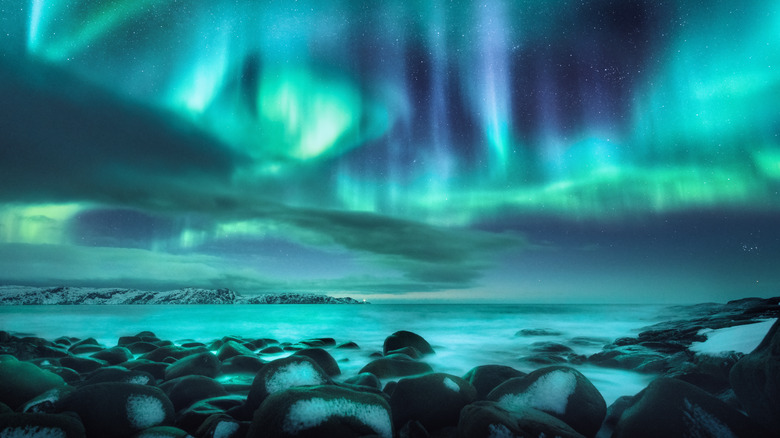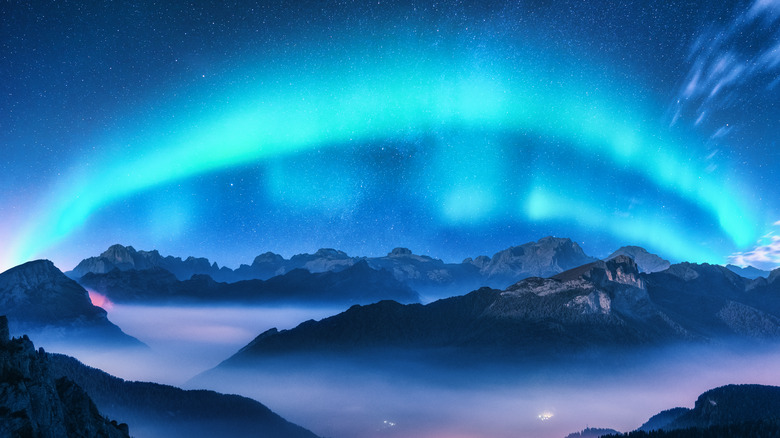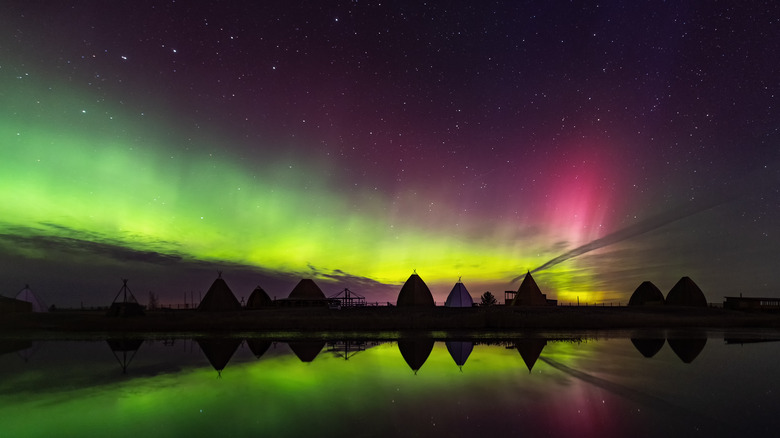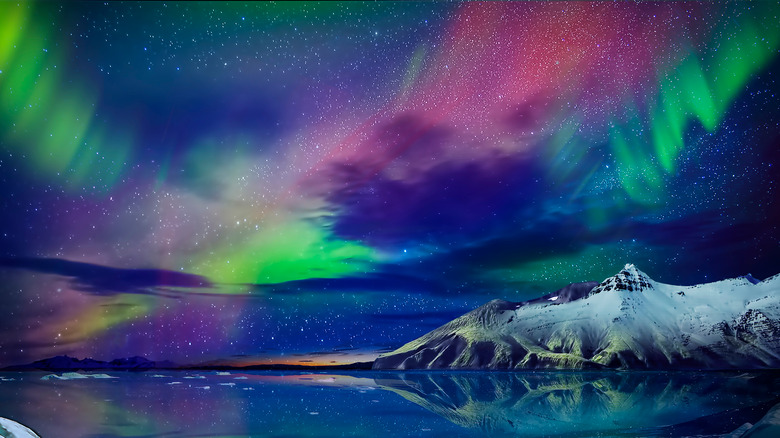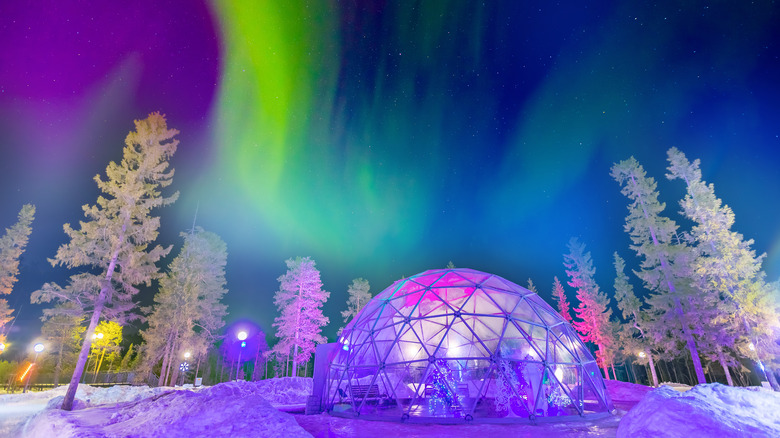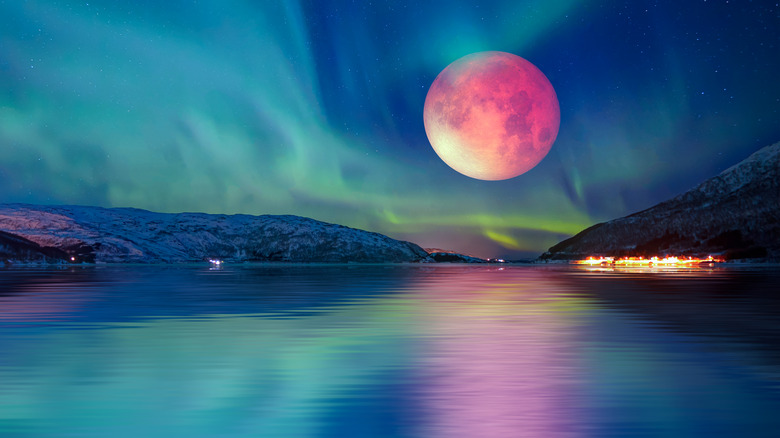What Causes Auroras In The Sky?
Even only in pictures, auroras (or aurorae) are a stunning, nearly mystical sight to behold. The "Holy Grail of skywatching," as Space puts it, it's easy to see why auroras have enchanted the imaginations of people going back millennia. One North American Inuit legend describes them as lights playing around with a walrus head. Vikings, on the other hand, believed that auroras were reflections off of Valkyrie armor, those warriors who escort the battle-slain to an exalted afterlife in Valhalla with Odin.
The term "aurora" was first coined by early-Enlightenment astronomer Galileo Galilei, whose support of a Copernican, heliocentric (sun at the center) model of the solar system landed him in house arrest for heresy from 1633 until his death in 1642 (via History). "Aurora," the general term for any and all similar atmospheric phenomena in either the north or south hemisphere, was the Roman name of the goddess of the dawn. "Borealis," a term we use to describe auroras in the northern hemisphere (i.e., "aurora borealis"), comes from the name for the Greek god of the wind. Galileo, an Italian living in Earth's northern hemisphere, never beheld auroras in the southern hemisphere, now denoted by the far more prosaic "australis" — "aurora australis" — which simply means "southern" in Latin, per Etymology Online. It took all the way until the 20th century for Norwegian scientist Kristian Birkeland to figure out auroras' connection to magnetism and plasma, and why they exist at all (via Plasma Universe).
Plasma colliding with Earth's atmosphere
The appearance of auroras in both the northern and southern hemispheres provides us with a clue about their origin: Auroras depend on magnetic poles. As Discover the World explains, auroras appear between 60 and 75 degrees of both positive and negative latitude — positive in the northern hemisphere, aka, "the northern lights," and negative in the southern hemisphere, aka, "the southern lights." These degrees offset from the equator, so that 90 degrees latitude runs directly up or down along Earth's rotational axis toward our planet's poles. Auroras stop short of the poles by 15 degrees, though, which provides us with another important clue about how they function: Angle of impact matters, specifically from solar radiation.
Even though the sun looks stable from its average distance of 150 million kilometers (93 million miles) from Earth (per Space), it's in a constant state of adjustment, flux, and variability. As it roils through a typical 11-year cycle, it produces phenomena such as sunspots, flares, coronal ejections, and solar wind (also per Space).
Solar wind occurs when the sun emits blasts of super-hot gas called plasma, via National Geographic. This gas is composed of charged particles — ions — that zip off through space and strike Earth and other planetary bodies in our solar system. These particles get snared by Earth's magnetic field up in the ionosphere (a layer of the atmosphere), and their electrons ride Earth's magnetic field lines and collide with atmospheric gases. Boom: instant aurora.
Shining, shimmering, splendid
Because auroras are formed by charged particles — ions — the color of the aurora changes depending on the type of gas the ions come into contact with: oxygen, carbon dioxide, nitrogen, helium, and so on. Aurora color also depends on how high the gases are in the atmosphere, and even how "excited" the gases are (i.e., how many electrons — negatively charged particles — occupy its energy shells).
When ions from the sun collide with hydrogen and helium in the atmosphere, they produce a blue and purple aurora, as National Geographic tells us. Nitrogen produces a reddish-bluish (aka, purplish) aurora. If ions strike oxygen, as is common, an aurora can appear green-yellow — this is the most common color, and appears in low altitudes. If oxygen is high in the atmosphere, though, an aurora can appear red. And if an aurora appears solidly green? This means its oxygen molecules are in the process of losing electrons (going from an excited to a "ground" state).
As for the "shimmer" or "dance" of an aurora, this occurs when lines of Earth's magnetic field momentarily snap and reconnect, via Web Exhibits. Magnetic fields collect energy, like a battery. If a field's lines shift, move, or disconnect in any way, its particles shoot off. This is similar to the kind of electrostatic discharge that we've all felt if someone rubs a thick carpet with a foot and then zaps a friend.
Norwegian physicist Kristian Birkeland figured auroras out
Because of the latitude at which auroras appear — between 60 and 75 degrees — certain countries are ideally situated to see them. Looking at the globe, there's far more landmass in the northern hemisphere, which means that countries such as Canada, Norway, Finland, Sweden, Russia, and the United States (Alaska) provide ideal aurora viewing grounds. This might be why the terms "northern lights" and "aurora borealis" (as opposed to "southern lights" and "aurora australis") crop up more often. It might also be why a Norwegian scientist, born in Oslo, was ideally situated to crack the aurora puzzle.
As Daily Scandinavian explains, inventor and physicist Kristian Olaf Birkeland (1867-1917) led an expedition to northern Norway during the winter of 1899-1900 to research auroras. Birkeland was a prodigy at a young age, publishing his first scientific paper at 18, and becoming a full physics professor at the University of Oslo at age 31 (via Plasma Universe). Over the course of his life he researched cathode rays, comets, the sun and sunspots, Earth's magnetism, and patented the electromagnetic cannon, electric blankets, hearing aids, and more. He was nominated for the Nobel Prize no less than seven times.
Birkeland was inspired by the burgeoning x-ray technology of his day. He thought, similar to a "magnetized ball in a vacuum" experiment he'd run, that particles from the sun were striking Earth and causing auroras. Turns out he was 100% correct.
Mysteries and money-making
Even though we understand what causes auroras, they still present some mysteries for researchers. For instance, when solar wind-created ions from the sun get snared by Earth's magnetic field, they don't simply travel towards the poles, they accelerate toward them, as Sky at Night Magazine says. Why? We have no idea. However, the phenomenon is similar to how televisions function, as Exploratorium explains. In televisions, electrons are shot toward the back of a TV screen. They accelerate, hit the screen, and create a multicolor composite that people see on the front face. In the atmosphere, the multicolor composite comes from electrons colliding with atmospheric gases.
We don't have to have auroras perfectly figured out to be able to enjoy them, though. Winter resorts like Kakslauttanen offer visitors the chance to sleep in aurora-viewing glass igloos from August 24 to April (like the kind pictured above). Granted, such accommodations are not at all what you'd call "cheap" — the least expensive, single-room option can run over $800 for two people for a single night at a non-discounted rate. Besides, you can always just hike out from a normal hotel and stare up at the sky. But for those willing to take a once-in-a-lifetime trip, they're an option. It's true that their location in Lapland in northern Finland, near Urko Kekkonen National Park, makes them ideal. Alternatively, sites like Hurtigruten offer things like 6- and 12-day cruise options around Norway for those able to spring for it.
A solar system-wide phenomenon
Auroras don't just exist on Earth, but on every planet in our solar system except for Mercury, including some large moons like Ganymede, via Sky at Night Magazine. Peering past the visual light spectrum and into infrared and ultraviolet reveals even more varieties of aurora on gas giants like Jupiter.
Earth's aurora-generating magnetic field comes from the same reason why certain bicycle lights turn on when a bicycle's wheels start rotating. The presence of iron in our planet's core isn't enough to generate electromagnetism. It's the churning of liquid metal set at odds with the rotation of the planet that generates Earth's magnetic field, as Cosmos Magazine explains; a dynamo, in other words. We're lucky that we've got such a magnetic field encasing our planet, too, because it acts as a shield against things like, well, the solar wind that causes auroras. Without it, radiation would have killed any chance for the development of life, and our atmosphere would basically "leak" into space. Earth really is perfectly suited not just to create life, but lives of beauty.
On a planet like Mars, which doesn't have a magnetic field, auroras occur not when ions get caught in its magnetic field lines (it doesn't have any), but when solar wind just smashes into the planet's upper atmosphere. Even then, auroras only appear in little patches across the planet, and only very, very faintly, because Mar's atmosphere is 140 times thinner than Earth's.
